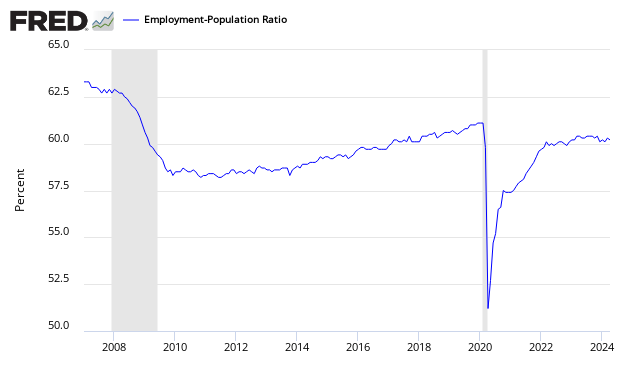Â
 The March 2014 BLS jobs report headlines were slightly weaker than expected. But the unadjusted data says this report is relatively strong. The growth trend lines are still decelerating because the previous two months were so weak.
The March 2014 BLS jobs report headlines were slightly weaker than expected. But the unadjusted data says this report is relatively strong. The growth trend lines are still decelerating because the previous two months were so weak.
- The trend growth lines on the establishment unadjusted employment numbers is still decelerating – but the March data is stronger than the previous month’s.
Unadjusted Non-Farm Private Employment – Year-over-Year Change (blue bars) and Year-over-Year Growth Acceleration / Deceleration (red line)

/images/z bls2.png
- The unadjusted growth this month was the strongest March since 2006 (year-over-year comparisons).
- economic intuitive sectors of employment were positive.
- This month’s report internals (comparing household to establishment data sets) were fairly inconsistent with the household survey showing seasonally adjusted employment growth of 503,000 vs the headline establishment number of 192,000.
- The National Federation of Independent Business (NFIB) statement on the Jobs report is below.
A summary of the employment situation:
- BLS reported: 192K (non-farm) and 192K (non-farm private). Unemployment unchanged at 6.7%
- ADP reported: 191K (non-farm private)
- Market expected: 175K to 275K (non-farm with consensus at 206K), 175K to 270K (non-farm private with consensus at 215K), 6.6% to 6.7% unemployment (consensus 6.6%)
- In Econintersect’s March 2014 economic forecast released in late February, we estimated non-farm private payroll growth at 120,000 (unadjusted based on economic potential) and 170,000 (fudged based on current overrun of economic potential).
The BLS reports seasonally adjusted data. This data is highly manipulated, and Econintersect believes the unadjusted data gives a clearer picture of the jobs situation.
Non-seasonally adjusted non-farm payrolls rose 831,000 – the strongest growth since 2006.
Historical Unadjusted Private Non-Farm Jobs Growth Between Februarys and Marchs (Table B-1, data in thousands) – unadjusted (blue line) vs seasonally adjusted (red line)

/images/bls non-adjusted change.PNG
Last month’s seasonally adjusted employment was slightly revised upward.
Change in Seasonally Adjusted Non-Farm Payrolls Between Originally Reported (blue bars) and Current Estimates (red bars)
 /images/z bls1.png
/images/z bls1.png
Most of the analysis below uses unadjusted data, and presents an alternative view to the headline data.
Unemployment
The BLS reported U-3 (headline) unemployment was unchanged at 6.7% with the U-6 “all in†unemployment rate (including those working part time who want a full time job) up 0.1% at 12.7%. These numbers are volatile as they are created from the household survey.
BLS U-3 Headline Unemployment (red line, left axis), U-6 All In Unemployment (blue line, left axis), and Median Duration of Unemployment (green line, right axis)

Econintersect has an interpretation of employment supply slack using the BLS unadjusted data base, demonstrated by the graph below.
Employment-Population Ratio

The jobs picture when you view the population as a whole. This ratio is determined by household survey.
- Econintersect uses employment-populations ratios to monitor the jobless situation. The headline unemployment number requires the BLS to guess at the size of the workforce, then guess again who is employed or not employed. In employment – population ratios, the population is a given and the guess is who is employed.
- In the latest BLS report employment-population ratio improved 0.1 to 58.9 – this ratio is above its short term trend between 58.5 and 58.6. The employment-population ratio tells you the percent of the population with a job. Each 0.1% increment represents approximately 300,000 jobs. [Note: these are seasonally adjusted numbers – and we are relying on the BLS to get this seasonal adjustment factor correct]. An unchanged ratio would be telling you that jobs growth was around 150,000 – as this is approximately the new entries to the labor market caused by population growth.

